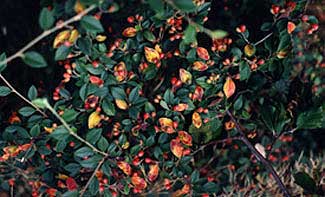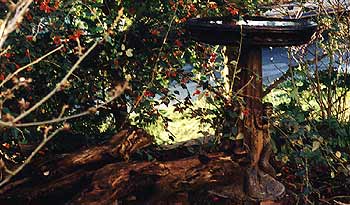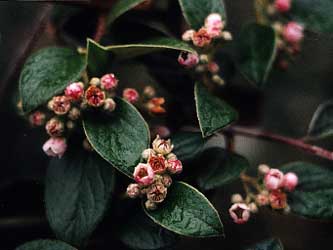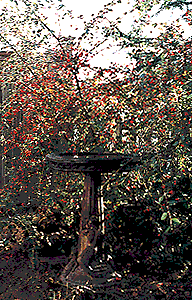 | |
| This tangle of Franchet's is shown in September with still-ripening berries. The percentage of leaves seen here to be turning yellow & red will soon drop off, but the majority which are still green will in fact remain so throughout winter, truly a semi-evergreen shrub. The pictures below were taken in mid-December, of the same shrub viewed from different angels. At the height of winter it is still a colorful delight. | |
Fountaining Franchet's Cotoneaster
"To me, the garden is a doorway to other worlds; one of them, of course, is the world of birds. The garden is their dinner table, bursting with bugs & worms & succulent berries."
-Anne Raver,
1995
Long ago I pronounced it Cotton-Easter after my socks & a Christian holiday; how embarrassing was that. Cuh-TOE-knee-ASS-ter after your toes, your knee, & your ass is much less goofy.1995
Franchet's cotoneaster (Cotoneaster franchetii) is named for a French botanist. The main one in our woodland gardens forms an arbor over the front stairs leading down to the street. I've given that one its own separate page & you can see it on the Adventures of a Cotoneaster Arbor page.
The present page has portraits of the oldest of the self-planted specimens that over time became scattered about the gardens, from that original grandmother on the arbor. Additional Franchet's cotoneasters pop up all the time, & we'd have scores of them if I didn't weed them back.
 In July this cotoneaster is covered over with lovely small white & pink flowers. Around September & October, these shrubs become weighted down with red-orange berries, & some of these berries will still be on the branches at winter's end.
In July this cotoneaster is covered over with lovely small white & pink flowers. Around September & October, these shrubs become weighted down with red-orange berries, & some of these berries will still be on the branches at winter's end.Though some of the Fall leaves turn yellow with streaks of red & fall off, most of the leaves remain on the branches for a semi-evergreen. So it has a wondrously dominant personality for all seasons & is especially welcome in winter when surrounding dissiduous shrubs are leafless. By the time it begins to look a little thin from leaf loss, it is already April, & new leaves are filling it back in.
Some varieties of cotoneasters can get stringy & homely with age, but this one provides nothing short of a fountain of elegance & has become a favorite for me.
 Originally from Tibet & China & very hardy, before we bought this place the south slope gardens were totally neglected, yet the Franchets thrived & propagated itself. An arching wide growth is typical. It can be pruned any time but supposedly best in February, though bad pruning is the chief reason so many cotoneasters look ugly. You have to be able to permit this shrub to reach its own idea of its full sweep. If you plant it somewhere where it often needs to be pruned away from paths or neighboring plants is a sure way to end up with an ugly shrub.
Originally from Tibet & China & very hardy, before we bought this place the south slope gardens were totally neglected, yet the Franchets thrived & propagated itself. An arching wide growth is typical. It can be pruned any time but supposedly best in February, though bad pruning is the chief reason so many cotoneasters look ugly. You have to be able to permit this shrub to reach its own idea of its full sweep. If you plant it somewhere where it often needs to be pruned away from paths or neighboring plants is a sure way to end up with an ugly shrub.On the other hand, it could be pruned clear to the ground & when it grows back, it'll be a small twiggy shrub for the first year, & could be cut back every spring if such a little Franchets were wanted. I tried to dig out two large unwanted specimens that grew too aggressively blocking the sidewalk. But the root system had grown mostly under a retainer wall & under the sidewalk, so could not be removed by digging. I dislike using toxins in the garden, so poisoning it was not an option. I settled for pruning the side-by-side shrubs flat to the ground. When they grew back, they formed a short groundcover of fountaining slender limbs. As growth is rapid, it would only take one year for them to be growing into the sidewalk again, but I rather liked how it looked as first-year twigs, & have decided to keep these "extra" shrubs as groundcovers by seasonally trimming them to the ground. But of course it is the old large specimens that have real "presence."
 As you may already have gathered, it can be slightly invasive, not troublesomely so, but ours has planted itself in several places where the berries have fallen along the decades. A couple years ago I swept up a lot of Franchets leaf-fall & fallen berries & used them as the organic content of a new gardening area, foolishly failing to realize all those berries would be producing Franchets seedlings for a long time to come. But they were easy to pull up, & I removed the seedlings before they were a foot tall.
As you may already have gathered, it can be slightly invasive, not troublesomely so, but ours has planted itself in several places where the berries have fallen along the decades. A couple years ago I swept up a lot of Franchets leaf-fall & fallen berries & used them as the organic content of a new gardening area, foolishly failing to realize all those berries would be producing Franchets seedlings for a long time to come. But they were easy to pull up, & I removed the seedlings before they were a foot tall.These several extra bushes are none so old as on the stairway arbor, but the biggest & nicest of the self-planted ones (the one in these pictures) is eight feet tall & almost as wide. I keep it somewhat underlimbed so that I can have a shade-garden underneath, & added a Y-shaped trellis to keep it propped up in front lest the shade garden become too dark under its fountaining limbs. New limbs come in so rapidly that underlimbing is needed once a year or the shade garden beneath it would be completely obscured. It overhangs a birdbath, giving visiting birds some footing above the water.
Another self-planted Franchet consisted of one branch only, very odd, it sprang right out of the ground straight upward to about a twelve foot length, having no side-branches at all! This was most unnatural & none of the other specimens have done anything even slightly similar. I almost removed it when cleaning up the underbrush of that area but was so impressed by it getting so long & thin that I decided to tie it into an arch, hoping its trunk hardens up nicely in time & becomes a permanent arched. Alas, during a snow storm it got crushed down & broken, so I did finally remove what was left. Another self-planted specimen is shown on another page, beside the front porch behind a weeping green beech. It has a more careless form, & needs often to be trimmed back.
The two main Franchets — the grandma that became an arbor, & the middle-aged fountaining specimen over the birdbath — are the most beautiful because having sufficient room to not require heavy pruning. They are highly decorative with their pink summer flowers & grey-green leaves, bright autumn & elegant sweep of limbs. Anyone lucky enough to have just the right specimen will have a gorgeous plant indeed.